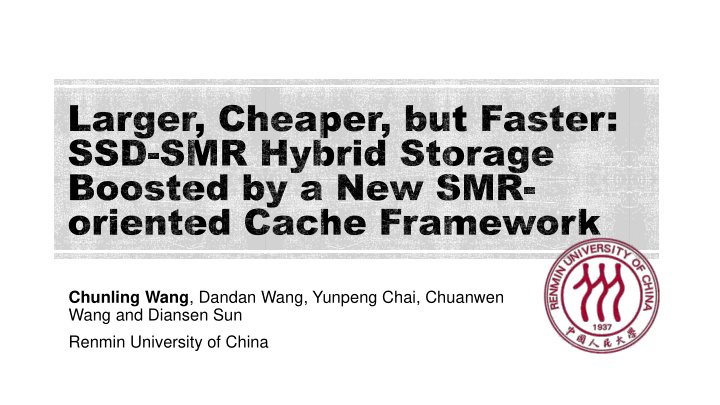



Chunling Wang , Dandan Wang, Yunpeng Chai, Chuanwen Wang and Diansen Sun Renmin University of China
Data volume is growing 44ZB in 2020! How to store? Flash arrays, DRAM-based storage : high costs, reliability, or limited capacity Conventional Magnetic Recording (CMR) : limited recording density(1T bit/in 2 ) Shingled Magnetic Recording (SMR) : larger, cheaper, but slower SSD+SMR = Hybrid Storage : larger, cheaper, but faster ??
Hybrid Storage + LRU ≠ faster Why? Do not consider Write Amplification of SMR disk Cache Hit Rates vs. SMR Write Amplification Be larger, cheaper, but faster
overlapped tracks write a block write a band eg: a Seagate 5TB SMR disk (ST5000AS0011) a 20GB non-overlapped tracks write buffer an aggressive manner to clean the FIFO queue band size: 17~36MB Max write amplification: 5TB/20GB= 256 !
41.3x ~171.5x 113.0x on average
Small LBA range + SMR 1.37x ≈ CMR 93.2% of CMR 15.11x 8.6% of CMR ↘
Write Requests Write Requests Write Requests S S S Limit written LBA range => SMR Write Amplification ↘ SSD Cache SSD Cache S 1 S 2 S 1 x R wa1 Challenge: conflict objectives > S 2 x R wa2 High cache hit rate R wa R wa1 R wa 2 Low SMR Write Amplification SMR LBA Range SMR LBA Range SMR LBA Range (a) SMR-only (b) Hybrid Storage (c) Hybrid Storage Storage + LRU etc. + a better plan
Partially Open Region for Eviction ( PORE ) : a new SMR-orientated cache framework CLEAN block DIRTY block / To reduce Write Amplification SSD Cache Open Region & Forbidden Region … a b c d To protect cache hit rates Block-level eviction hot cold Periodically region division eviction SMR LBA Range Open Region Forbidden Region
Basic Unit of Region Division: Zone Open Zone & Forbidden Zone Open Forbidden Zones Zones … SMR … … Bands
/ DIRTY block Forbidden Zone Open Zone SSD Cache CLEAN block … c b a Chose a to evict, but a is cold hot from Forbidden Zone, skip
/ DIRTY block Forbidden Zone Open Zone SSD Cache CLEAN block … c b a Chose b to evict, b is clean, cold evict without flushing to hot SMR disk
/ DIRTY block Forbidden Zone Open Zone SSD Cache CLEAN block … c a Chose c to evict, c is from cold Open Zone, evict and flush hot to SMR disk
/ DIRTY block Forbidden Zone Open Zone SSD Cache CLEAN block … a After flushing c cold hot c
/ DIRTY block Forbidden Zone Open Zone SSD Cache CLEAN block … a After a periodical time, cold hot re-divide Open Zone and Forbidden Zone
Which Zones should be evicted from SSD cache? Zones in Z4 — Open Zone Which Zones should be protected in SSD cache? Zones in Z1 — Forbidden Zone Zones in Z2, Z3 need to be considered
Coverage First ( CF ) Minimal SMR Write Amplification Popularity First ( PF ) Maximal cache hit rates BaLancing between Zone Coverage and Popularity ( BL ) Both considered
SSD-SMR prototype storage (https://github.com/wcl14/smr-ssd-cache) Trace replay module SSD cache module SMR disk emulator module Statistics module System Linux 2.6.32 DRAM 8 GB CMR 7200RPM 500GB SSD 240GB PCIe SMR 5900RPM 5TB
Traces
Managing a Read-Write Cache Total I/O time vs. SMR-only: 11.8x ↘ vs. CMR-only: 3.3 ↘ vs. LRU: 2.8x ↘ vs. LRU-band: 1.6x ↘
compared with LRU 16.15% ↘ Managing a Read-Write Cache Read Hit Rates SMR-only: 45.60 compared with LRU 4.9% ↘ LRU: 53.28 LRU-band: 28.37 PORE: 12.80 Write Amplification Write Hit Rates
PF is highest CF/BL is little lower BL is always fastest! Write Hit Rates CF/BL is much smaller Total I/O time Write Amplification
No effect 10MB~20MB is best 10MB~20MB is best
Longer is better, but it has limitation Period Length / SMR write buffer = 1 is best! Period Length / SMR write buffer = 1 is best!
written LBA range of mix reaches 1.15 TB 33.4 hours 87.5% 85.0% 13.0 hours 5.69 hours
SSD+SMR using PORE can make SMR be primary storage in much more situations Come up with a new way to reduce SMR Write Amplification and improve hybrid storage performance by limiting written LBA range Compared with LRU, PORE improves 2.84x on average, while compared with CMR-only, PORE improves 3.26x on average.
https://github.com/wcl14/smr-ssd-cache ypchai@ruc.edu.cn
compared with LRU 7.89% ↘ Managing a Write-Only Cache Write Hit Rates 34.9x 2.02x 10.2x 4.60x SMR-only: 43.85 LRU: 52.41 LRU-band: 21.99 PORE: 7.76 Write Amplification Total I/O time
Recommend
More recommend